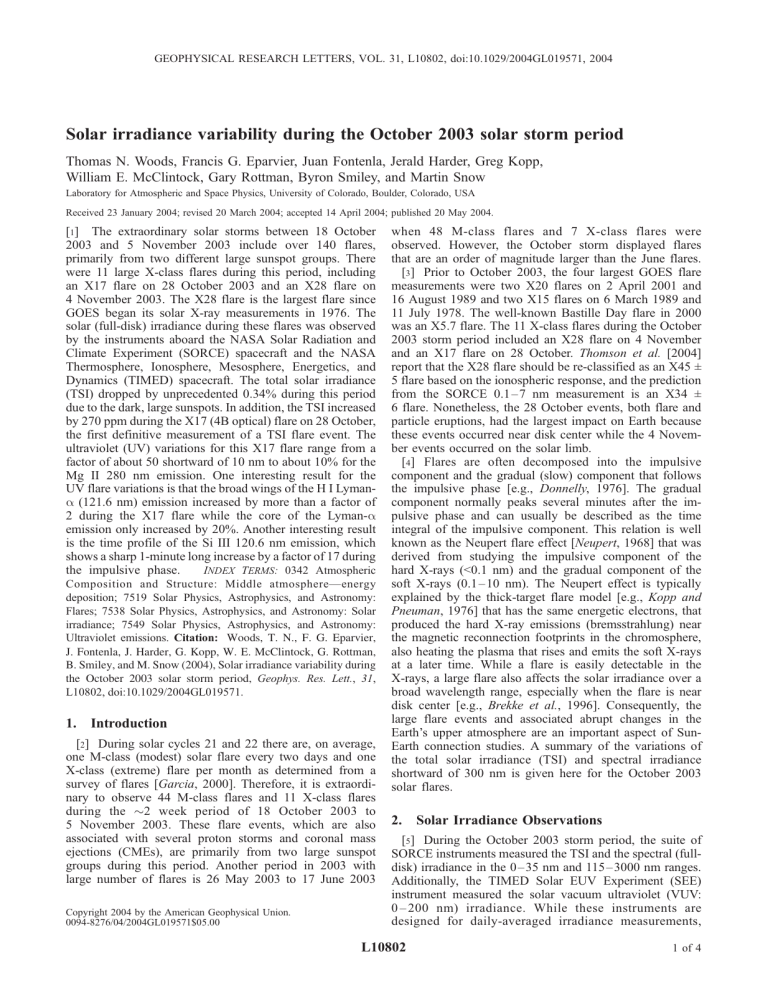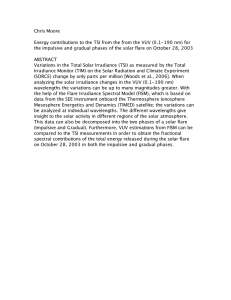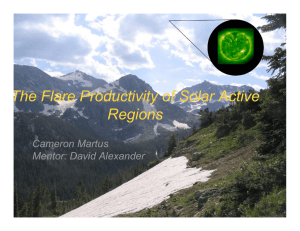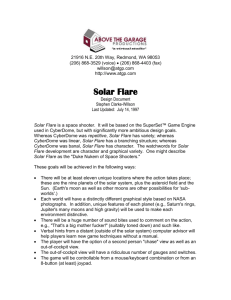Solar irradiance variability during the October 2003 solar storm period

GEOPHYSICAL RESEARCH LETTERS, VOL. 31, L10802, doi:10.1029/2004GL019571, 2004
Solar irradiance variability during the October 2003 solar storm period
Thomas N. Woods, Francis G. Eparvier, Juan Fontenla, Jerald Harder, Greg Kopp,
William E. McClintock, Gary Rottman, Byron Smiley, and Martin Snow
Laboratory for Atmospheric and Space Physics, University of Colorado, Boulder, Colorado, USA
Received 23 January 2004; revised 20 March 2004; accepted 14 April 2004; published 20 May 2004.
[
1
] The extraordinary solar storms between 18 October
2003 and 5 November 2003 include over 140 flares, primarily from two different large sunspot groups. There were 11 large X-class flares during this period, including an X17 flare on 28 October 2003 and an X28 flare on
4 November 2003. The X28 flare is the largest flare since
GOES began its solar X-ray measurements in 1976. The solar (full-disk) irradiance during these flares was observed by the instruments aboard the NASA Solar Radiation and
Climate Experiment (SORCE) spacecraft and the NASA
Thermosphere, Ionosphere, Mesosphere, Energetics, and
Dynamics (TIMED) spacecraft. The total solar irradiance
(TSI) dropped by unprecedented 0.34% during this period due to the dark, large sunspots. In addition, the TSI increased by 270 ppm during the X17 (4B optical) flare on 28 October, the first definitive measurement of a TSI flare event. The ultraviolet (UV) variations for this X17 flare range from a factor of about 50 shortward of 10 nm to about 10% for the
Mg II 280 nm emission. One interesting result for the
UV flare variations is that the broad wings of the H I Lymana (121.6 nm) emission increased by more than a factor of
2 during the X17 flare while the core of the Lymana emission only increased by 20%. Another interesting result is the time profile of the Si III 120.6 nm emission, which shows a sharp 1-minute long increase by a factor of 17 during the impulsive phase.
I NDEX T ERMS : 0342 Atmospheric
Composition and Structure: Middle atmosphere—energy deposition; 7519 Solar Physics, Astrophysics, and Astronomy:
Flares; 7538 Solar Physics, Astrophysics, and Astronomy: Solar irradiance; 7549 Solar Physics, Astrophysics, and Astronomy:
Ultraviolet emissions.
Citation: Woods, T. N., F. G. Eparvier,
J. Fontenla, J. Harder, G. Kopp, W. E. McClintock, G. Rottman,
B. Smiley, and M. Snow (2004), Solar irradiance variability during the October 2003 solar storm period, Geophys. Res. Lett.
, 31 ,
L10802, doi:10.1029/2004GL019571.
1.
[
2
Introduction
] During solar cycles 21 and 22 there are, on average, one M-class (modest) solar flare every two days and one
X-class (extreme) flare per month as determined from a survey of flares [ Garcia , 2000]. Therefore, it is extraordinary to observe 44 M-class flares and 11 X-class flares during the 2 week period of 18 October 2003 to
5 November 2003. These flare events, which are also associated with several proton storms and coronal mass ejections (CMEs), are primarily from two large sunspot groups during this period. Another period in 2003 with large number of flares is 26 May 2003 to 17 June 2003
Copyright 2004 by the American Geophysical Union.
0094-8276/04/2004GL019571$05.00
when 48 M-class flares and 7 X-class flares were observed. However, the October storm displayed flares that are an order of magnitude larger than the June flares.
[
3
] Prior to October 2003, the four largest GOES flare measurements were two X20 flares on 2 April 2001 and
16 August 1989 and two X15 flares on 6 March 1989 and
11 July 1978. The well-known Bastille Day flare in 2000 was an X5.7 flare. The 11 X-class flares during the October
2003 storm period included an X28 flare on 4 November and an X17 flare on 28 October.
Thomson et al.
[2004] report that the X28 flare should be re-classified as an X45 ±
5 flare based on the ionospheric response, and the prediction from the SORCE 0.1 – 7 nm measurement is an X34 ±
6 flare. Nonetheless, the 28 October events, both flare and particle eruptions, had the largest impact on Earth because these events occurred near disk center while the 4 November events occurred on the solar limb.
[
4
] Flares are often decomposed into the impulsive component and the gradual (slow) component that follows the impulsive phase [e.g., Donnelly , 1976]. The gradual component normally peaks several minutes after the impulsive phase and can usually be described as the time integral of the impulsive component. This relation is well known as the Neupert flare effect [ Neupert , 1968] that was derived from studying the impulsive component of the hard X-rays (<0.1 nm) and the gradual component of the soft X-rays (0.1 – 10 nm). The Neupert effect is typically explained by the thick-target flare model [e.g., Kopp and
Pneuman , 1976] that has the same energetic electrons, that produced the hard X-ray emissions (bremsstrahlung) near the magnetic reconnection footprints in the chromosphere, also heating the plasma that rises and emits the soft X-rays at a later time. While a flare is easily detectable in the
X-rays, a large flare also affects the solar irradiance over a broad wavelength range, especially when the flare is near disk center [e.g., Brekke et al.
, 1996]. Consequently, the large flare events and associated abrupt changes in the
Earth’s upper atmosphere are an important aspect of Sun-
Earth connection studies. A summary of the variations of the total solar irradiance (TSI) and spectral irradiance shortward of 300 nm is given here for the October 2003 solar flares.
2.
Solar Irradiance Observations
[
5
] During the October 2003 storm period, the suite of
SORCE instruments measured the TSI and the spectral (fulldisk) irradiance in the 0 – 35 nm and 115 – 3000 nm ranges.
Additionally, the TIMED Solar EUV Experiment (SEE) instrument measured the solar vacuum ultraviolet (VUV:
0 – 200 nm) irradiance. While these instruments are designed for daily-averaged irradiance measurements,
L10802
1 of 4
L10802 WOODS ET AL.: OCT. 2003 SOLAR IRRADIANCE VARIABILITY L10802
Figure 1.
Time series of solar irradiance measurements during the October 2003 storm period. The irradiance measurements of the TSI and at 477 – 483 nm, of Mg II at
280 nm, of H I at 121.6 nm, and at 0.1 – 7 nm are representative of the solar emissions from the photosphere, chromosphere, transition region, and corona, respectively.
The GOES X-ray plot includes the C, M, and X flare classifications.
[
8
] The SORCE spacecraft was launched in January
2003, and its daily measurements of the solar irradiance began in March 2003. The SORCE solar observations average 70 minutes per orbit (70% duty cycle). Both
SOLSTICE and SIM normally take an orbit to obtain a full spectral scan, so their measurements are not optimized for flare observations. However, the SOLSTICE has a mini-scan experiment for the H I Lymana
(121.6 nm) and Mg II (280 nm) emissions during one orbit each day, and this experiment, which has a time cadence of 1 minute, was fortuitously running during the X17 flare on 28 October. The SORCE XPS and TIM are well suited for flares with their observing time cadences of 5 min and 100 s, respectively.
[
9
] The time series of selected SORCE and TIMED solar irradiance observations during the October 2003 storm period are shown in Figure 1 along with the continuous
X-ray observations made by the GOES X-Ray Sensor
(XRS). The XUV measurements from XPS have similar response for flare events as the GOES X-ray measurements, and both of these instruments recorded solar cycle maximum levels throughout the 18 October to 5 November period. The SOLSTICE Mg II (280 nm) and H I
(121.6 nm) irradiances near 30 October have solar cycle maximum levels, which decrease as the active regions approach the limb where the emissions are more optically thick and the projected areas are smaller. In general, the chromospheric and transition region irradiances indicate a significant increase for only a few of the large flares.
Reaching minimum values on 29 October, the SIM visible and TIM TSI measurements show a 0.34% decrease because the large sunspots appear darker for the visible wavelengths. The TSI decrease during this period is the largest short-term decrease in the satellite-based TSI record.
SORCE observed all 11 X-class flares during the storm period, and TIMED observed 7 of these flares.
[
6
] The TIMED SEE consists of two instruments to measure the solar VUV spectral irradiance from 0.1 to
195 nm [ Woods et al.
, 1998]. The EUV Grating Spectrograph (EGS) has a spectral range of 26 to 195 nm with 0.4
nm spectral resolution. The XUV Photometer System (XPS) measures the solar irradiance from 0.1 to 34 nm with each photometer filter having a bandpass of 7 nm. The accuracy of the SEE solar irradiances is about 15%. The SEE solar observations are limited to 3 minutes per orbit (3% duty cycle) and obtain full VUV coverage with a 10 s time cadence for its observations.
[
7
] The SORCE spacecraft consists of four different instruments to measure the TSI and solar spectral irradiance.
The TSI is measured by the Total Irradiance Monitor (TIM), which has a design accuracy of 100 ppm [ Lawrence et al.
,
2000; Kopp et al.
, 2004]. The Spectral Irradiance Monitor
(SIM) measures the solar spectral irradiance from 200 to
3000 nm with a resolving power of 300 and a design accuracy of 300 ppm [ Harder et al.
, 2000]. There are two copies of the Solar Stellar Irradiance Experiment
(SOLSTICE) aboard SORCE to measure the solar ultraviolet irradiance with an accuracy of 5% and with 0.1 nm spectral resolution from 115 to 190 nm with one channel and from 170 to 310 nm with the other channel [ McClintock et al.
, 2000]. The SORCE XPS is essentially identical to the
XPS that is part of the TIMED SEE.
3.
The X17 Flare on 28 October 2003
[
10
] The X17 flare and associated proton storm and
CME on 28 October 2003 from the large, complex sunspot group #10486 were the most dramatic events during this storm period as these events occurred while the active region was near disk center. While the X28 flare on
4 November was larger in the X-rays, the solar UV irradiance increases were larger for the X17 flare.
Donnelly
[1976] had shown that the solar EUV radiation is sensitive to flare location while the X-rays are insensitive. The solar irradiance changes for the X17 flare period are shown in
Figure 2 for a few select wavelengths. As expected, the
GOES X-ray and XPS 0.1 – 7 nm measurements have the largest variations, being more than an order of magnitude change. The SEE measurements occurred a few minutes after the peak but still show an increase by a factor of 2 for the EUV range. The H I Lymana (121.6 nm) emission core and the Mg II h and k emissions show a modest increase of 20% and 12%, respectively. Both are consistent with other FUV emissions measured by the SEE EGS. The
SIM instrument did not observe this flare in the visible due to its configuration during this time period.
3.1.
TSI Flare Detection
[
11
] The TIM recorded an increase by 270 ppm
(360 mW/m
2
) for the TSI during the X17 flare, being the first time that the TSI has been unambiguously observed to
2 of 4
L10802 WOODS ET AL.: OCT. 2003 SOLAR IRRADIANCE VARIABILITY L10802
Figure 2.
being about 10:30 UT for the UV emissions and about
9:30 UT for the X-ray emissions. The time derivative of the
GOES X-rays (blue line) is an estimate for the hard X-ray time series.
Time series of solar irradiance measurements during the X17 flare on 28 October 2003. The flare increase is taken between the peak value and the pre-flare value,
(Neupert effect) as there are no hard X-ray measurements from RHESSI for this flare event. In addition, its line profile has a blue shift during the impulsive phase (11:00 UT to
11:10 UT) of 0.008 nm. At SOLSTICE’s spectral resolution of 0.1 nm, the blue component could be a combination of blue shifted Si III and possible blends with other emissions, such as the Cr XX 120.59 nm emission. A blue shift of the Si III emission is more likely as the Cr XX emission, which is formed at similar temperature as Fe XXI, is not expected to have a strong impulsive phase component
[ Mason et al.
, 1986]. A blue shift of 0.008 nm indicates an outflow of 20 km/s.
Mariska et al.
[1993] reports that many flares have blueshifted profiles with an average velocity of
60 km/s.
3.3.
Flare Spectral Variations
[
14
] The ratio of the flare irradiance spectrum to the preflare spectrum as shown in Figure 3 clarifies which spectral features increased during the flare event. The SOLSTICE flare spectra are at the flare peak, and its pre-flare spectrum is taken near 10:30 UT. The SORCE XPS also measured the flare peak, but its pre-flare spectrum is taken from the previous orbit (9:30 UT) as there was a significant, slow rise of the XUV irradiance before the X17 flare. The
TIMED SEE flare spectrum is 7 min after the X-ray flare peak, and its pre-flare spectrum is taken near 9:40 UT.
[
15
] As expected, the largest variations are observed in the X-ray and EUV ranges. The GOES 0.1 – 0.8 nm irradiance has a flare to pre-flare ratio of 570, and the flare ratio for the XPS 0.1 – 7 nm irradiance is 42. The EUV region
(27 – 115 nm), as measured by the SEE EGS, shows a factor of 2 or more variation for most emissions. Because TIMED observed the flare a few minutes after the peak, the maximum solar EUV variations are expected to be larger change as result of a flare since routine TSI measurements began in 1978. The noise level for the TIM TSI measurement is 2 ppm and typical short-term variations of the TSI due to solar oscillations are 50 ppm, so this TSI flare measurement is significantly above the TIM noise level and larger than the normal solar fluctuations for the TSI. White light flares are observed regularly [e.g., Neidig , 1989], but this flare detection by TIM quantifies for the first time the flare’s effect on the TSI.
3.2.
Timing of Peaks
[
12
] Another interesting aspect of these flare measurements is the time difference when each emission peaks. The
TSI (photosphere), Mg II emission (chromosphere), and H I emission (transition region) peak first near 11:05 UT. Then the X-ray emissions (corona) peak a few minutes later. The
TSI and UV emissions have both an impulsive component similar to the hard X-rays and a gradual component similar to the soft X-rays. The temporal variations of the Mg II and
H I emissions are similar to each other but with the H I emission reaching a peak first. These irradiance time series are comparable in profile to the OSO-8 radiance time series of the Mg II and H I emissions during the 15 April 1978 flare [ Lemaire et al.
, 1984].
[
13
] The Si III 120.6 nm emission during the X17 flare has an interesting time profile. This emission suddenly increased during the impulsive phase by a factor of 17 for only a minute. The impulsive phase is estimated in Figure 2 as the derivative of the GOES soft X-ray time series
Figure 3.
Flare and pre-flare solar irradiance ratios for the
X17 flare on 28 October 2003 in 3 spectral ranges. The lower curves in each panel are the flare spectra on a log scale to clarify the spectral features.
3 of 4
L10802 WOODS ET AL.: OCT. 2003 SOLAR IRRADIANCE VARIABILITY L10802 than those measured by TIMED. The SOLSTICE Lymana time series indicates a scaling factor of 1.8 between the flare peak and the time of the EGS measurement. The
TIMED EGS relative variations in Figure 3c are scaled by factor of 1.8.
[
16
] The FUV region (115 – 200 nm) shows a smaller flare ratio that steadily declines going towards the longer wavelengths. The flare ratio is not significantly above 1.0
longward of 170 nm, except for the Mg II 280 nm chromospheric emissions that show an increase of 12% in
Figure 3b. The transition region emissions, such as the C IV
155.6 nm emission, show the largest variations in the FUV range and are similar to the variations of the EUV emissions. The FUV spectral shape for the flare ratio is similar to earlier results given by Woods et al.
[2003] and Brekke et al.
[1996]. It has been known for some time from Lymana photometer measurements that the Lymana (121.6 nm) emission has little or no variations during a flare [ Smith and
Smith , 1963]. For this X17 flare the H I Lymana emission core only shows a modest increase of 20%; but interestingly, the broad wings of the Lymana emission show a factor of
2 increase in Figure 3a. These results are similar to the 1992
X3 flare results [ Brekke et al.
, 1996]. The new Lymana information from the X17 flare is that the blue wing increased before the red wing during the impulsive phase.
3.4.
TSI Contributions
[
17
] The contribution of the solar UV variations to the
TSI change for the X17 flare is examined using the measured spectral changes that are represented in Figure 3.
This analysis indicates that 23% of the TSI increase during the X17 flare is due to VUV increases. The percent TSI changes by the XUV (0 – 27 nm), EUV (27 – 120 nm), and
FUV (120 – 195 nm) are 19%, 1.4%, and 2.3%, respectively.
This result indicates that the majority of the flare’s energy is released at wavelengths longward of 200 nm and shortward of 27 nm.
4.
Summary
[
18
] The spectacular number of flares, associated proton storms, and CMEs between 18 October 2003 and 5 November 2003 is an extraordinary sequence of events that will surely lead to a better understanding of the Sun’s eruptive behavior and on how sudden solar changes affect
Earth’s atmosphere, including effects on the composition, temperature, and dynamics of both the ionosphere and neutral atmosphere. An important new outcome from the
X17 flare on 28 October 2003 is the first detection of a flare in the TSI.
[
19
]
Acknowledgment.
This work has been supported by NASA grants NAS5-97045 (SORCE) and NAG5-11408 (TIMED SEE) at the
University of Colorado.
References
Brekke, P., G. J. Rottman, J. Fontenla, and P. G. Judge (1996), The ultraviolet spectrum of a 3B class flare observed with SOLSTICE, Astrophys.
J.
, 468 , 418.
Donnelly, R. F. (1976), Empirical models of solar flare X ray and EUV emission for use in studying their E and F region effects, J. Geophys.
Res.
, 81 , 4745.
Garcia, H. (2000), Thermal-spatial analysis of medium and large solar flares, 1976 to 1996, Astrophys. J. Suppl.
, 127 , 189.
Harder, J., G. M. Lawrence, G. Rottman, and T. Woods (2000), Solar
Spectral Irradiance Monitor (SIM), Metrologia , 37 , 415.
Kopp, G., G. Lawrence, and G. Rottman (2004), Total Irradiance Monitor design and on-orbit functionality, SPIE Proceedings , 5171 4 , in press.
Kopp, R. A., and G. W. Pneuman (1976), Magnetic reconnection in the corona and the loop prominence phenomenon, Solar Phys.
, 50 , 85.
Lawrence, G. M., G. Rottman, J. Harder, and T. Woods (2000), Solar Total
Irradiance Monitor (TIM), Metrologia , 37 , 407.
Lemaire, P., M. Choucq-Bruston, and J.-C. Vial (1984), Simultaneous
H and K Ca II, h and k Mg II, L a and L b H I profiles of the April 15,
1978 solar flare observed with the OSO-8/L.P.S.P. experiment, Solar
Phys.
, 90 , 63.
Mariska, J. T., G. A. Doschek, and R. D. Bentley (1993), Astrophys. J.
, 419 ,
251.
Mason, H. E., R. A. Shine, J. B. Gurman, and R. A. Harrison (1986),
Spectral line profiles of Fe XXI 1354.1 A
Mission, Astrophys. J.
, 309 , 435.
McClintock, W. E., G. J. Rottman, and T. N. Woods (2000), SOLar STellar
Irradiance Comparison Experiment II (SOLSTICE II) for the NASA
Earth Observing Systems Solar Radiation and Climate Experiment
(SORCE) mission, SPIE Proceedings , 4135 , 225.
Neidig, D. F. (1989), The importance of solar white-light flares, Solar
Phys.
, 121 , 261.
Neupert, W. M. (1968), Comparison of solar X-Ray line emission with microwave emission during flares, Astrophys. J.
, 153 , L59.
Smith, H. J., and E. V. P. Smith (1963), Solar Flares , p. 168, MacMillian,
Old Tappan, N. J.
Thomson, N. R., C. J. Rodger, and R. L. Dowden (2004), Ionosphere gives size of greatest solar flare, Geophys. Res. Lett.
, 31 , L06803, doi:10.1029/
2003GL019345.
Woods, T. N., S. M. Bailey, W. K. Peterson, S. C. Solomon, H. P. Warren,
F. G. Eparvier, H. Garcia, C. W. Carlson, and J. P. McFadden (2003),
Solar extreme ultraviolet variability of the X-class flare on 21 April 2002 and the terrestrial photoelectron response, Space Weather , 1 (1), 1001, doi:10.1029/2003SW000010.
Woods, T., F. Eparvier, S. Bailey, S. C. Solomon, G. Rottman, G. Lawrence,
R. Roble, O. R. White, J. Lean, and W. K. Tobiska (1998), TIMED Solar
EUV Experiment, SPIE Proceedings , 3442 , 180.
T. N. Woods, F. G. Eparvier, J. Fontenla, J. Harder, G. Kopp, W. E.
McClintock, G. Rottman, B. Smiley, and M. Snow, Laboratory for
Atmospheric and Space Physics, University of Colorado, 1234 Innovation
Dr., Boulder, CO 80303, USA. (tom.woods@lasp.colorado.edu)
4 of 4




